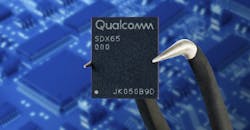Qualcomm Turns Up 5G Speeds With X65 Modem and RF Chips
Qualcomm has rolled out its new generation of 5G modems that support data rates of up to 10 Gbps for use in flagship smartphones and other segments, including fixed wireless access equipment, in 2021.
The San Diego, California-based company said the Snapdragon X65 delivers a large generational leap of performance and world’s most advanced 5G baseband processor to date. The chip takes advantage of a 4-nanometer process from an unnamed foundry partner, imparting it with a smaller footprint and more power efficiency than the previous X60, introduced in 2020 and manufactured on the 5-nanometer node.
Qualcomm has long been the world's leading vendor of cellular modems used in smartphones and it counts Apple, Samsung, and top phone manufacturers around the world as its customers. Qualcomm said its improvements to the Snapdragon X65 not only translate to faster overall speeds for 5G phones but also help bring longer battery life, better coverage, and a massive boost in capacity to 5G networks.
The Snapdragon X65 is at the heart of what Qualcomm calls its modem-to-antenna system for 5G—an end-to-end package of components, ranging from the baseband modem to the power amplifiers, filters, and other radio frequency (RF) chips and antenna modules surrounding it, tightly integrated together to save space and power. The X65 modem, paired with its new generation of power amplifiers and other parts, handles more frequency bands and a larger bandwidth than the X60, Qualcomm said.
The Snapdragon X65 supports all the major bands and combinations used in 5G technology, including the millimeter waves that require more base stations to offer faster transmission speed but have a relatively short range and can be blocked or scrambled by walls or other objects. The X65 can also support slower sub-6 GHz bands that can be broadcast over wider regions than millimeter waves.
The chip has an advanced arsenal of technology that guarantees it can be used to connect to any 5G network in any part of the world where its customers sell devices. Like the previous generation, the X65 supports frequency-division duplex (FDD) and time-division duplex (TDD) bands on 5G standalone (SA) and non-standalone (NSA) networks. The baseband modem can also use carrier aggregation (CA) to broadcast over sub-6 and millimeter waves bands at the same time, boosting data rates.
The baseband modem aggregates up to 10 millimeter wave bands for a total 1000 MHz of bandwidth, up from 800 MHz in the previous generation. The chip boosts bandwidth from 200 MHz to 300 MHz in the sub-6 range (an improvement of 50%) by aggregating several bands at the same time. The boost translates to faster transmission rates and allows many more devices to connect to 5G networks.
According to Qualcomm, the modem has maximum download speeds of 10 Gbps — or about 10 times faster than the fastest 4G LTE modem — compared to 7.5 Gbps for last year's model. While consumers will likely never see speeds of 10 Gbps, the new chip's ability to aggregate millimeter waves and other bands will lift the "performance floor" for 5G smartphones, resulting in faster average speeds than 4G.
The X65 modem is set to launch in products by late 2021. But the most advanced tools in its arsenal — such as aggregating sub-6 bands and millimeter waves — have yet to be deployed on 5G networks.
Qualcomm said the architecture of the Snapdragon X65 modem is upgradable, giving customers the ability to build in features using software updates. That "future-proofs" the modem and allows it to accommodate any changes to the 5G standard, including the 3GPP's latest Release 16, over time. Future-proofing can prolong the life of a smartphone or other device, keeping it up-to-date longer.
"Snapdragon X65 brings together all the key 5G breakthroughs," Durga Malladi, Qualcomm's senior vice president and general manager of 4G and 5G technology, said in a statement. He said that the X65 modem is not only ideal for smartphones but also fixed wireless networks, where 5G systems are used to bring faster broadband to houses and businesses, as well as to factory floors and cars.
Qualcomm said that the Snapdragon X65 will be used in 40 different product designs for 5G fixed wireless technology that telecom gear makers plan to bring to market by the second half of 2021.
The semiconductor giant is also flexing its muscles with new radio frequency front-end (RFFE) chips, a market where it is growing aggressively so that it can sell more pre-integrated solutions to smartphone makers. The new product portfolio includes an integrated 4G/5G power amplifier module, QPM6679, and its latest dual-band diversity module, the QDM5579, which comes in a compact form factor.
Qualcomm also unveiled a new generation of its millimeter wave antenna module, the QTM545. The module — one of the key components of 5G smartphones on the market — pumps out higher transmit power while keeping the same compact footprint as the previous generation model. The QTM545 supports the full range of millimeter wave bands used globally, including bands in the 41 GHz range.
Phone makers put these compact modules around the edges of the device. When one of the millimeter wave antennas is blocked by a hand or other obstacle, the others can be used to tune into 5G networks.
Qualcomm also launched its new generation of envelope trackers to further improve power efficiency. The QET7100 is up to 30% more energy efficient than the average power-tracking technology from rivals, opening the door to slimmer smartphones with the all-day battery life that consumers want. The QET7100 works with 4G or 5G power amplifiers and uses less space than the previous model.
Lastly, Qualcomm introduced what it called the world's first antenna tuning technology to uses artificial intelligence (AI) to detect hand grips around the smartphone and dynamically tune the antennas in real time to boost performance. The antenna tuning technology can pinpoint hand positions 30% more accurately than its predecessor. That results in faster speeds, better coverage and longer battery life.
Qualcomm rolled out a widely accessible sibling of the Snapdragon X65 — the X62 — which tops out at speeds of 4.4 Gbps with 400 MHz of total bandwidth and is targeted at less expensive smartphones.
About the Author
James Morra
Senior Editor
James Morra is the senior editor for Electronic Design, covering the semiconductor industry and new technology trends, with a focus on power electronics and power management. He also reports on the business behind electrical engineering, including the electronics supply chain. He joined Electronic Design in 2015 and is based in Chicago, Illinois.



